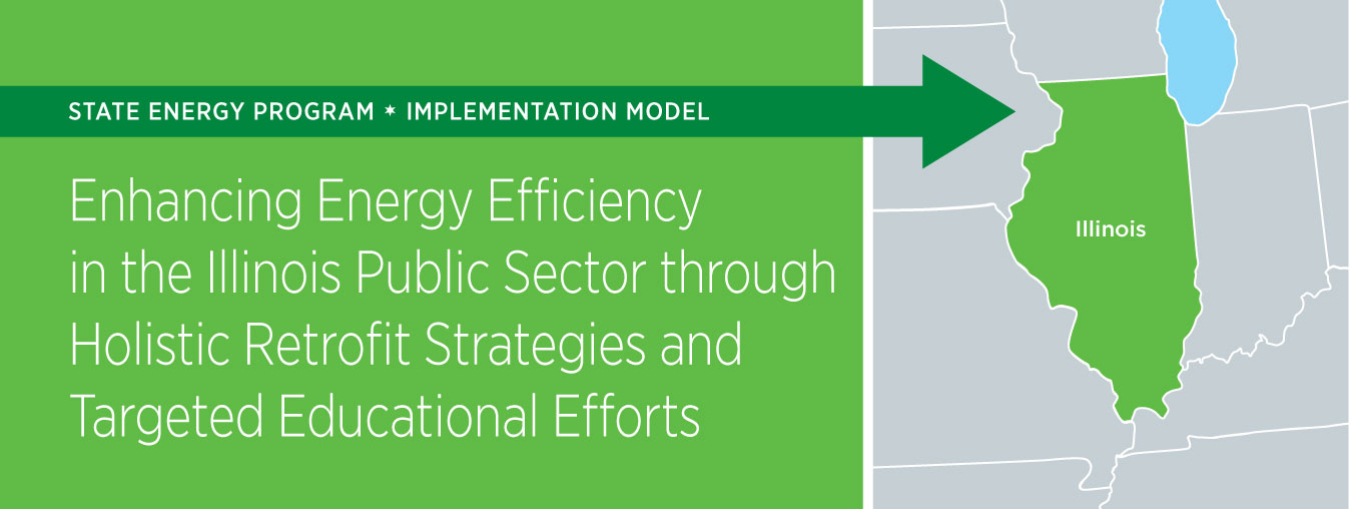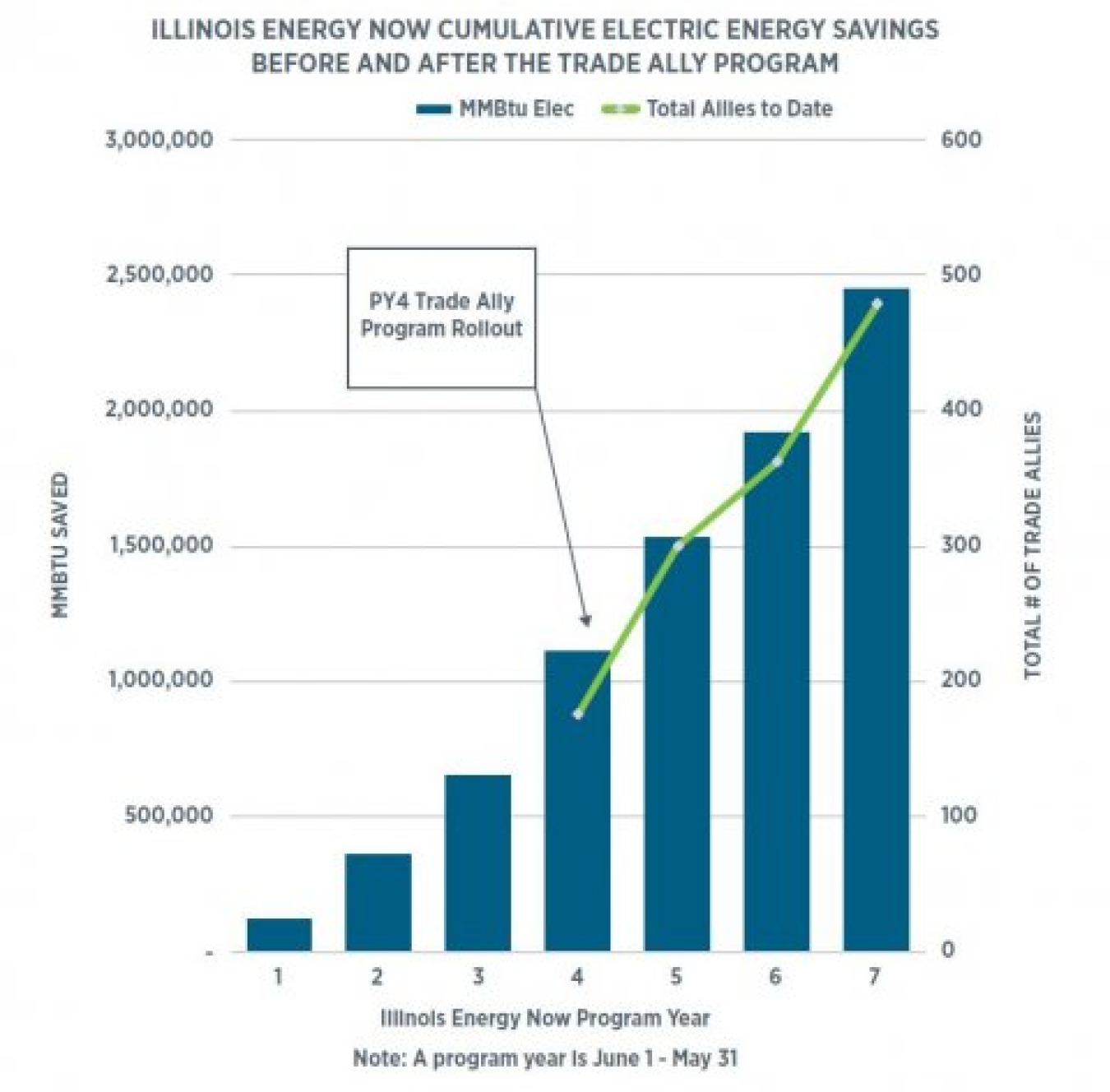
This page highlights the State of Illinois' Implementation Model, developed with funding from the State Energy Program’s Competitive Financial Assistance program. Download Enhancing Energy Efficiency in the Illinois Public Sector - Illinois.
Goal

Achieve a 20% reduction of building electricity consumption in the Illinois public sector by 2020, from 2006 baseline.
Barrier

Limited public sector participation in energy efficiency projects.
Solution

The Illinois Department of Commerce and Economic Opportunity created and implemented the Illinois Energy Now Trade Ally Program, an initiative that utilizes recognition to foster competition among energy efficiency providers. The Program advances public sector participation in energy efficiency projects by empowering Trade Allies through enhanced networking, training, and technical assistance opportunities.
Outcomes

In less than one year, Trade Allies completed more than 300 new energy efficiency projects in the public sector, a 40% increase over projects completed in 2012. These projects encompassed a wide variety of upgrades that helped Illinois achieve energy savings of over 5.9 million British thermal units (MBtu) and thus meet its annual public sector energy efficiency milestones in 2015.
Overview
Illinois public sector facilities have long been an underutilized source of energy efficiency. The state’s wastewater treatment facilities, municipal facilities, street lighting, and K-12 schools are the highest-consuming facilities in terms of kilowatt hours (kWh), and therefore have the largest economic potential for gains in electric efficiency. For Illinois, this potential represents a great challenge and an even greater opportunity to meet ambitious goals for reducing public sector building electricity consumption. In response to this challenge, Illinois developed the Trade Ally Program to incentivize retrofits and increase energy efficiency in buildings. The Illinois Department of Commerce received financial support through a State Energy Program Competitive award to develop and implement the Trade Ally Program between 2012 and 2015.
Policies
The Illinois Power Agency Act (SB 1592) of 2007 changed the game for energy efficiency initiatives by creating an Energy Efficiency Portfolio Standard (EEPS). The EEPS requires state utilities to reduce electricity consumption on a yearly, graduated schedule – from a 0.2% reduction in consumption in 2008 to a 2% reduction in 2015 and each year thereafter. The legislation paved the way for Illinois Energy Now, a portfolio of electric and natural gas efficiency incentives, programs, and services for public sector energy efficiency upgrades.
Process
While Illinois Energy Now offered a range of electric and natural gas efficiency programs for the public sector, they were undersubscribed. The Illinois Department of Commerce recognized the need to harness the power of the private sector to tap the energy efficiency potential of the public sector.
Program Design
The Department actively sought counsel from trusted experts to help design new, broader marketing strategies to engage the public sector in energy efficiency retrofit projects: the University of Illinois at Chicago Energy Resources Center (ERC), the Smart Energy Design Assistance Center (SEDAC), and the Midwest Energy Efficiency Alliance (MEEA).
Determined to boost the public sector’s interest in energy efficiency retrofits, the Department of Commerce enlisted its team of experts to devise the Trade Ally Program. The program launched a year later. ERC acted as the lead partner in day-to-day operations while the Department of Commerce provided oversight. ERC brought on full time staff with marketing, business development, and program management expertise to work with Department of Commerce, SEDAC, MEEA, and the Illinois Association of County Board Members to set up the program for success.
The Trade Ally Program features three elements critical to success in increasing the number of energy efficiency retrofits in Illinois public sector buildings:
- Fosters networking between public sector and private energy service providers.
Networking has been a key driver of success in the program by increasing the energy efficiency business conducted between the public sector and Trade Allies. “Trade Allies” comprise mechanical and lighting contractors, engineers, architects, energy service companies, wholesalers, distributors, and retailers who are experts in customized public sector energy solutions.
At rallies, trade shows, and lunch-and-learns, Trade Allies and prospective public clients can connect and discuss services, prices, incentives, and returns on investment.
- Encourages friendly competition.
Trade Allies performing the greatest number of public sector energy efficiency upgrade projects are recognized and rewarded publicly, which further incentivizes Trade Ally action.
- Empowers the private sector.
Trade Allies are trained on the rules and regulations of Illinois Energy Now programs. The training allows them to design and market their services effectively to ensure that their public sector clients leverage all applicable Illinois Energy Now incentives and thus maximize the financial return from their retrofit projects.
Implementation
Once the Trade Ally Program had been designed and staff was in place, it was time to engage the potential Trade Allies.
- Trade Ally Recruitment
The Department of Commerce used its strong network of energy professionals to facilitate recruitment leads. ERC staff began recruitment efforts of Trade Allies via emails and phone calls and soon after that, launched the Trade Ally Program website. The team did not stop at digital outreach; they also canvassed industry trade groups like the Illinois Energy Professionals Association and the Illinois Mechanical & Specialty Contractors Association. They even facilitated events, such as rallies, in different geographic regions to educate potential recruitments in energy efficiency.
- Trade Ally Training
Once recruited, new Trade Allies register with Illinois Energy Now and provide information on the services they offer and their service area. The Trade Ally program coordinator reviews and approves new Trade Allies for membership listings on the program website. All new Trade Allies undergo Illinois Energy Now Program training, which consists of five webinars conducted annually by ERC and Department of Commerce staff at no cost to the ally. The webinars cover program history, special offers, the available incentives for energy efficiency upgrade projects, and the Illinois Energy Now application process.
The training curriculum is updated twice a year to allow Trade Allies to learn about changes to incentive levels in the program. Illinois Energy Now newsletters are emailed to the program distribution list once a month and include program updates, upcoming events, and project highlights to enable Trade Allies to stay current.
Between 2012 and 2015, ERC and the Department of Commerce conducted more than 25 training webinars with over 2,300 participants. The Department of Commerce also hosted lunch-and-learns to educate Trade Allies and prospective public clientele on new energy efficiency technologies such as LED and induction lighting.
- Recognition for Top-Performing Trade Allies
Trade Allies are listed on the Illinois Energy Now website. In order to incentivize strong performance from Trade Allies and spur competition among them, they are listed in order of number of public sector energy efficiency upgrade projects completed. As a Trade Ally completes more public sector projects its name rises to the top of the list, increasing its visibility to potential clients.
Trade Allies are also recognized at rallies for the number of public sector retrofit projects they complete. Awards are given to the top performers in the northern, central, and southern regions of Illinois. Award-winning Trade Allies advertise their accolades online, at conferences, and at workshops.
This level of public recognition is critical to creating a business incentive for Trade Allies and helps in the recruitment process as well.
Outreach
The Department of Commerce – determined to increase the uptake of the Illinois Energy Now incentives – strove to facilitate engagement between Trade Allies and the public sector to support and encourage energy efficiency upgrades. The Department educated public sector officials on the benefits of energy efficiency upgrades through presentations at Energy Trade Shows. Trade shows provide a forum for Trade Allies to network with prospective public sector clientele, speak to public sector officials, and negotiate business deals, as well as participate as exhibitors. From September 2012 to March 2015, the Department of Commerce held four Energy Trade Shows with more than 1,000 participants.
Measuring Success
The Department of Commerce maintains a comprehensive database of results from all programs, including Illinois Energy Now. These results are evaluated each program year by an independent assessor in order to verify program outcomes and adjust savings attributed to the programs, where applicable. The assessor is selected through a competitive Request for Application process.
The progress of Illinois public sector energy efficiency is measured using the following metrics:
- Number of energy efficiency projects completed in the public sector. An independent evaluator is used to confirm the final count
- Number of Trade Allies partnering with Illinois Energy Now, tracked on a quarterly basis
- Number of whole building energy assessments conducted at public facilities
- Annual percent reduction in public sector building electricity consumption.
Ultimately, the Illinois Commerce Commission oversees the rate-payer funded programs that are administered by the state and by investor-owned utilities. The Illinois Energy Now program evaluation results are regularly reported to the Illinois Commerce Commission. In addition, high-level metrics (e.g., first-year value of energy efficiency savings) are reported quarterly to the Governor’s Office of Management & Budget.
Outcomes
The success of the Trade Ally program enabled Illinois to boost the energy efficiency of its public sector buildings significantly. From September 2012 to March 2015, the number of Trade Allies grew from 30 to 456. During the latest complete Illinois Energy Now program year, more than 300 new energy efficiency projects were completed by Trade Allies – a 40% increase over 2012.
In accordance with the Illinois Power Agency Act, the state has met its goal of reducing public sector electricity consumption by 1.4% in the year commencing June 1, 2013. Forthcoming audits will likely confirm that legally mandated 2014 public sector energy savings have been achieved.
As the Trade Ally Program matured and more Trade Allies were recruited, energy savings increased dramatically. As the graph below demonstrates, energy savings have grown year after year. Total energy savings in the Illinois public sector after the launch of the Trade Ally Program topped 5.9 million MBtu.

